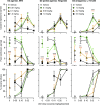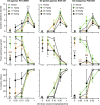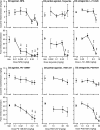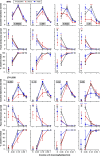Effects of Acute and Chronic Treatments with Dopamine D2 and D3 Receptor Ligands on Cocaine versus Food Choice in Rats
- PMID: 28473458
- PMCID: PMC5469403
- DOI: 10.1124/jpet.117.241141
Effects of Acute and Chronic Treatments with Dopamine D2 and D3 Receptor Ligands on Cocaine versus Food Choice in Rats
Abstract
Dopamine D3 receptor ligands are potential medications for psychostimulant addiction. Medication assessment may benefit from preclinical studies that evaluate chronic medication effects on choice between an abused drug and an alternative, nondrug reinforcer. This study compared acute and chronic effects of dopamine D2- and D3-preferring ligands on choice between intravenous cocaine and palatable food in rats. Under baseline conditions, cocaine maintained dose-dependent increases in cocaine choice and reciprocal decreases in food choice. Acutely, the D2 agonist R-(-)-norpropylapomorphine (NPA) and antagonist L-741,626 [3-[[4-(4-chlorophenyl)-4-hydroxypiperidin-l-yl]methyl-1H-indole] produced leftward and rightward shifts in cocaine dose-effect curves, respectively, whereas the partial agonist terguride had no effect. All three drugs dose-dependently decreased food-maintained responding. Chronically, the effects of R-(-)-norpropylapomorphine and L-741,626 on cocaine self-administration showed marked tolerance, whereas suppression of food-reinforced behavior persisted. Acute effects of the D3 ligands were less systematic and most consistent with nonselective decreases in cocaine- and food-maintained responding. Chronically, the D3 agonist PF-592,379 [5-[(2R,5S)-5-methyl-4-propylmorpholin-2-yl]pyridin-2-amine] increased cocaine choice, whereas an intermediate dose of the D3 antagonist PG01037 [N-[(E)-4-[4-(2,3-dichlorophenyl)piperazin-1-yl]but-2-enyl]-4-pyridin-2-ylbenzamide] produced a therapeutically desirable decrease in cocaine choice early in treatment; however, tolerance to this effect developed, and lower and higher doses were ineffective. D3 ligands failed to significantly modify total cocaine intake but caused persistent decreases in food intake. Thus, D2-and D3-preferring ligands showed distinct profiles, consistent with different pharmacological actions. In addition, these results highlight the role of acute versus chronic treatment as a determinant of test drug effects. With the possible exception of the D3 antagonist PG01037, no ligand was promising in terms of cocaine addiction treatment.
Copyright © 2017 by The American Society for Pharmacology and Experimental Therapeutics.
Figures






Similar articles
-
Dopamine D3 and D2 receptor mechanisms in the abuse-related behavioral effects of cocaine: studies with preferential antagonists in squirrel monkeys.J Pharmacol Exp Ther. 2010 Aug;334(2):556-65. doi: 10.1124/jpet.110.167619. Epub 2010 May 21. J Pharmacol Exp Ther. 2010. PMID: 20494958 Free PMC article.
-
Effects of dopamine D2/D3 receptor ligands on food-cocaine choice in socially housed male cynomolgus monkeys.J Pharmacol Exp Ther. 2013 Feb;344(2):329-38. doi: 10.1124/jpet.112.201012. Epub 2012 Dec 4. J Pharmacol Exp Ther. 2013. PMID: 23211363 Free PMC article.
-
Effects of dopamine indirect agonists and selective D1-like and D2-like agonists and antagonists on cocaine self-administration and food maintained responding in rats.Neuropharmacology. 2004;47 Suppl 1:256-73. doi: 10.1016/j.neuropharm.2004.07.007. Neuropharmacology. 2004. PMID: 15464142
-
Pharmacological actions of NGB 2904, a selective dopamine D3 receptor antagonist, in animal models of drug addiction.CNS Drug Rev. 2007 Summer;13(2):240-59. doi: 10.1111/j.1527-3458.2007.00013.x. CNS Drug Rev. 2007. PMID: 17627675 Free PMC article. Review.
-
The role of central dopamine D3 receptors in drug addiction: a review of pharmacological evidence.Brain Res Brain Res Rev. 2005 Jul;49(1):77-105. doi: 10.1016/j.brainresrev.2004.12.033. Brain Res Brain Res Rev. 2005. PMID: 15960988 Free PMC article. Review.
Cited by
-
Medications Development for Treatment of Opioid Use Disorder.Cold Spring Harb Perspect Med. 2021 Jan 4;11(1):a039263. doi: 10.1101/cshperspect.a039263. Cold Spring Harb Perspect Med. 2021. PMID: 31932466 Free PMC article. Review.
-
The role of glucagon-like peptide 1 (GLP-1) in addictive disorders.Br J Pharmacol. 2022 Feb;179(4):625-641. doi: 10.1111/bph.15677. Br J Pharmacol. 2022. PMID: 34532853 Free PMC article. Review.
-
In vitro safety evaluation of dopamine D3R antagonist, R-VK4-116, as a potential medication for the treatment of opioid use disorder.PLoS One. 2024 Dec 16;19(12):e0315569. doi: 10.1371/journal.pone.0315569. eCollection 2024. PLoS One. 2024. PMID: 39680602 Free PMC article.
-
The highly selective dopamine D3R antagonist, R-VK4-40 attenuates oxycodone reward and augments analgesia in rodents.Neuropharmacology. 2019 Nov 1;158:107597. doi: 10.1016/j.neuropharm.2019.04.003. Epub 2019 Apr 8. Neuropharmacology. 2019. PMID: 30974107 Free PMC article.
-
(±)VK4-40, a novel dopamine D3 receptor partial agonist, attenuates cocaine reward and relapse in rodents.Br J Pharmacol. 2020 Oct;177(20):4796-4807. doi: 10.1111/bph.15244. Epub 2020 Sep 17. Br J Pharmacol. 2020. PMID: 32851643 Free PMC article.
References
-
- Attkins N, Betts A, Hepworth D, Heatherington AC. (2010) Pharmacokinetics and elucidation of the rates and routes of N-glucuronidation of PF-592379, an oral dopamine 3 agonist in rat, dog, and human. Xenobiotica 40:730–742. - PubMed
MeSH terms
Substances
Grants and funding
LinkOut - more resources
Full Text Sources
Other Literature Sources

